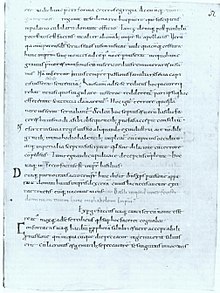Liutprand of Cremona
Most Reverend Liutprand of Cremona | |
|---|---|
Bishop of Cremona | |
 Liudprand of Cremona, Antapodosis (detail from III, c. 32-34) Northern Italy, second half of the 10th century. Munich, Bavarian State Library, Clm 6388, fol. 51r | |
| Church | Catholic Church |
| Diocese | Diocese of Cremona |
| Personal details | |
| Born | 920 |
| Died | 972 (aged 51–52) Cremona, Kingdom of Italy |
Liutprand, also Liudprand, Liuprand, Lioutio, Liucius, Liuzo, and Lioutsios (c. 920 – 972),
Early life and career
Liutprand was born into a prominent family from
Mission to Constantinople
In 949, Berengar II sent him on a goodwill mission as an apprentice diplomat[2] to the Byzantine court of Constantine VII Porphyrogenitus, with whom he became friendly. Liutprand went partly to learn Greek[3] and may have provided material for chapter 26 of Constantine VII's De Administrando Imperio.[1] Both Liutprand's father and his stepfather had been sent as ambassadors to Constantinople (927 and 942).[1] (Knowledge of Prince Igor's 941 attack on Constantinople was told by his stepfather as Liutprand wasn't in the city at the time).[4] Liutprand included in his later Antapodosis (950s) a glowing account of the hospitality he enjoyed there, including being carried into the audience hall on the shoulders of eunuchs, and Constantine's delight in receiving a gift of an additional four de luxe eunuchs from Liutprand.[2] Liutprand uses the word "carzimasium" for the eunuchs he brought, suggesting that all of their external genitalia had been removed.[5][6]
Bishop of Cremona
On his return, however, he fell out with Berengar, for which Liutprand avenged himself in his Antapodosis ("retribution"), and attached himself to Berengar's rival, the emperor
Second mission to Constantinople
He was frequently employed in missions to the
Liutprand's account of this embassy in the Relatio de Legatione Constantinopolitana is perhaps the most graphic and lively piece of writing which has come down to us from the 10th century. The detailed description of Constantinople and the Byzantine court is a document of rare value, though highly coloured by his hostility towards the Byzantine Empire. The Catholic Encyclopedia asserted "Liutprand's writings are a very important historical source for the tenth century; he is ever a strong partisan and is frequently unfair towards his adversaries."[citation needed]
Liutprand's candid account makes clear that often he was not as diplomatic as he might have been and Constanze Schummer has questioned how good a diplomat he really was in Constantinople, despite successes in the West.[2] On his second mission to Constantinople, for instance, after his purchases of purple textiles are confiscated, he tells the imperial party that at home whores and conjurers wear purple.[8] Schummer and others have speculated that Otto I did not actually see the Relatio or receive an accurate account of Liutprand's performance at Constantinople.
Whether he returned in 971 with the embassy to fetch Theophanu, the eventually negotiated bride, or not is uncertain,[1] but he may well have.[2] Liutprand probably died before 20 July 972, certainly before 5 March 973.[1] His successor as bishop of Cremona was installed in 973.
Works

- Antapodosis, seu rerum per Europam gestarum, Libri VI, a historical narrative, relating to events, largely in Italy, from 887 to 949. Compiled, according to Encyclopædia Britannica, "with the object of avenging himself upon Berengar and Willa his queen"[9]
- Historia Ottonis, a praise of his patron Otto, covering only the years from 960 to 964, written as a partisan of the Emperor
- Relatio de legatione Constantinopolitana ad Nicephorum Phocam covering the years 968 and 969
- The standard critical edition of all of Liudprand's works is Chiesa, Paolo (1998). Liudprandi Cremonensis, Antapodosis, Homelia Paschalis, Historia Ottonis, Relatio de Legatio Constantinopolitana. Turnhout: Brepols. ISBN 978-2-503-04561-0.
Works in English translation
- F. A. Wright, translator, The Works of Liudprand of Cremona London and New York 1930.
- J. J. Norwich, editor, Liutprand of Cremona, The Embassy to Constantinople and Other Writings. Everyman Library, London: Dent, 1993 (reprint, with new introduction, of the 1930 Wright translation).
- Brian Scott, editor and translator, Liudprand of Cremona, Relatio de Legatione Constantinopolitana. Bristol Classical Press, 1993.
- The Complete Works of Liudprand of Cremona, Paolo Squatriti, ed. and trans. Washington, D.C.: Catholic University of America Press, 2007.
References
- ^ ISBN 0195046528
- ^ ISBN 0860783383
- ^ Liutprand, Antapodosis, VI.2-3.
- ^ Hansen, Valerie (2020). The Year 1000. Penguin. p. 93.
- ISSN 1123-9883.
- ISBN 978-0-7156-3129-4.
- ISBN 1859862810
- ^ Liudprand, Leg., chapter 54.
- ^ Chisholm, Hugh, ed. (1911). . Encyclopædia Britannica. Vol. 16 (11th ed.). Cambridge University Press. p. 800.
External links
![]() This article incorporates text from a publication now in the public domain: Kirsch, Johann Peter (1910). "Liutprand of Cremona". In Herbermann, Charles (ed.). Catholic Encyclopedia. Vol. 9. New York: Robert Appleton Company.
This article incorporates text from a publication now in the public domain: Kirsch, Johann Peter (1910). "Liutprand of Cremona". In Herbermann, Charles (ed.). Catholic Encyclopedia. Vol. 9. New York: Robert Appleton Company.
- Chiesa, Paolo (2005). "LIUTPRANDO di Cremona". ISBN 978-8-81200032-6.
- Opera quae extant, editio princeps by Plantin, Antwerp 1640
- "The Works of Liudprand of Cremona London and New York 1930 F. A. Wright, translator
 Works by or about Liutprand of Cremona at Wikisource
Works by or about Liutprand of Cremona at Wikisource- Liutprand of Cremona
- Liutprand of Cremona - Zdravko Batzarov, Encyclopædia Orbis Latini
- Liutprand, Relatio - excerpts (in English)
- Opera Omnia by Migne Patrologia Latina with analytical indexes
